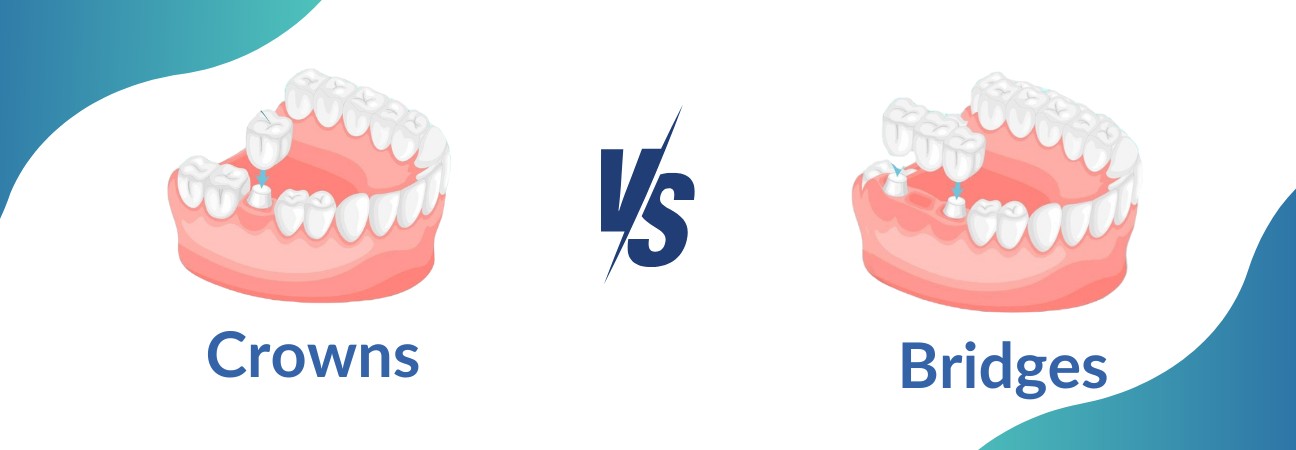When it comes to dental restorations, crowns and bridges are two popular options designed to restore function and aesthetics to your smile. Understanding the differences between these two treatments can help you make an informed decision about which one is best suited for your specific dental needs. This blog explores crowns and bridges, their benefits, and considerations to help you choose the right restoration for your oral health.
Understanding Crowns
A dental crown, often referred to as a "cap," is a custom-made restoration that completely covers a damaged or decayed tooth. Crowns are designed to restore the tooth's original shape, size, and strength while improving its appearance. These restorations can consist of multiple materials such as porcelain, ceramic, metal, or a mixture of these elements.
Indications For Crowns
- Severe Decay: When a tooth has extensive decay that cannot be treated with a filling, a crown is often necessary to restore its structure and function.
- Root Canal Treatment: Teeth that have undergone root canal therapy often require crowns to protect and reinforce them.
- Cracked or Fractured Teeth: Crowns are effective in stabilizing cracked or broken teeth, preventing further damage.
- Cosmetic Improvement: Crowns can enhance the appearance of discolored or misshaped teeth, providing a more aesthetically pleasing smile.
Advantages Of Crowns
- Strength and Durability: Crowns provide significant strength to weakened teeth, allowing them to withstand normal biting forces.
- Natural Appearance: Porcelain crowns can closely mimic the appearance of natural teeth, making them an excellent choice for visible areas.
- Longevity: With proper care, crowns can last many years, providing long-term solutions for dental problems.
Understanding Bridges
A dental bridge is a fixed restoration used to replace one or more missing teeth by bridging the gap between adjacent teeth. Bridges consist of two or more crowns (known as abutment crowns) placed on the teeth surrounding the gap, with a false tooth (or pontic) in between. Bridges can be made from various materials, including porcelain, gold, and dental alloys.
Indications For Bridges
- Missing Teeth: Bridges are primarily used to replace one or more missing teeth, restoring both function and aesthetics.
- Adjacent Healthy Teeth: Bridges require the support of healthy neighboring teeth, which are shaped to accommodate the crowns.
Advantages Of Bridges
- Restoration of Function: Bridges enable patients to chew and speak more effectively, restoring their ability to enjoy a varied diet.
- Prevention of Teeth Shifting: By filling the gap left by missing teeth, bridges help maintain the position of adjacent teeth, preventing them from shifting out of alignment.
- Aesthetic Improvement: Bridges can enhance the smile by filling gaps and providing a natural appearance.
Key Considerations When Choosing Between Crowns And Bridges
When deciding between crowns and bridges, there are several factors to consider:
- Extent of Dental Damage: If you have a damaged tooth, a crown may be the appropriate option. However, if you are missing one or more teeth, a bridge may be necessary to restore your smile.
- Number of Missing Teeth: Crowns are ideal for restoring individual teeth, while bridges are specifically designed for replacing multiple missing teeth in a row.
- Surrounding Teeth Health: Crowns can be used on individual damaged teeth without affecting adjacent teeth, while bridges rely on the health and stability of neighboring teeth.
- Longevity and Maintenance: Both crowns and bridges can last for many years with proper care. However, crowns may require less maintenance compared to bridges, as they do not rely on surrounding teeth for support.
- Cost and Insurance Coverage: The cost of crowns and bridges may vary based on the materials used and the complexity of the procedure. Consult your dental insurance provider to understand coverage options for both treatments.
Crowns and bridges are valuable dental restoration options that can significantly improve your oral health and enhance your smile. Understanding their differences, benefits, and considerations can help you make an informed choice about which treatment is right for you. Always consult with your dentist to evaluate your specific dental needs and develop a personalized treatment plan. With the right restoration, you can enjoy a healthy, functional, and beautiful smile for years to come.




